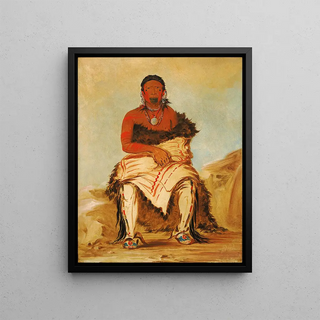Painting Lshahlestwhix Man Chief, a Pawnee Republican - George Catlin | Art print


View from behind

Frame (optional)
The art print of Lshahlestwhix Man Chief, a Pawnee republican - George Catlin, offers a fascinating insight into the world of Indigenous peoples of America. This iconic work, created by the artist George Catlin in the 19th century, is much more than a simple depiction of an Indian chief. It embodies the very essence of a rich and complex culture, while also reflecting the issues of artistic representation during a time of social and political upheaval. Catlin's art stands out for its ability to capture not only the physical features of his subjects but also their dignity and cultural identity, making this art print all the more meaningful.
Style and uniqueness of the work
George Catlin's style is characterized by a realistic approach, where every detail is carefully observed and transcribed. In the art print of Lshahlestwhix Man Chief, a Pawnee republican, vibrant colors and rich textures create a lively atmosphere that draws the eye and invites contemplation. Catlin employs painting techniques that highlight the pride and strength of his subject, while incorporating symbolic elements that evoke spirituality and the traditions of Indigenous peoples. This piece is not limited to a simple representation; it tells a story, that of a man and a people seeking recognition and respect in a rapidly changing world. The way Catlin plays with light and shadow enhances the emotional impact of the work, allowing the viewer to feel the depth of the human experience he aims to convey.
The artist and his influence
George Catlin, a pioneer of American art, dedicated much of his life to immortalizing Native American cultures through his work. Traveling across the United States, he had the opportunity to meet many chiefs and tribe members, striving to understand and depict their way of life. His work had a significant influence on the perception of Indigenous cultures in America and beyond, paving the way for a more nuanced and respectful appreciation of their history. Catlin was also a passionate advocate for the preservation of Native American traditions, and

Matte finish

View from behind

Frame (optional)
The art print of Lshahlestwhix Man Chief, a Pawnee republican - George Catlin, offers a fascinating insight into the world of Indigenous peoples of America. This iconic work, created by the artist George Catlin in the 19th century, is much more than a simple depiction of an Indian chief. It embodies the very essence of a rich and complex culture, while also reflecting the issues of artistic representation during a time of social and political upheaval. Catlin's art stands out for its ability to capture not only the physical features of his subjects but also their dignity and cultural identity, making this art print all the more meaningful.
Style and uniqueness of the work
George Catlin's style is characterized by a realistic approach, where every detail is carefully observed and transcribed. In the art print of Lshahlestwhix Man Chief, a Pawnee republican, vibrant colors and rich textures create a lively atmosphere that draws the eye and invites contemplation. Catlin employs painting techniques that highlight the pride and strength of his subject, while incorporating symbolic elements that evoke spirituality and the traditions of Indigenous peoples. This piece is not limited to a simple representation; it tells a story, that of a man and a people seeking recognition and respect in a rapidly changing world. The way Catlin plays with light and shadow enhances the emotional impact of the work, allowing the viewer to feel the depth of the human experience he aims to convey.
The artist and his influence
George Catlin, a pioneer of American art, dedicated much of his life to immortalizing Native American cultures through his work. Traveling across the United States, he had the opportunity to meet many chiefs and tribe members, striving to understand and depict their way of life. His work had a significant influence on the perception of Indigenous cultures in America and beyond, paving the way for a more nuanced and respectful appreciation of their history. Catlin was also a passionate advocate for the preservation of Native American traditions, and
12,34 €






